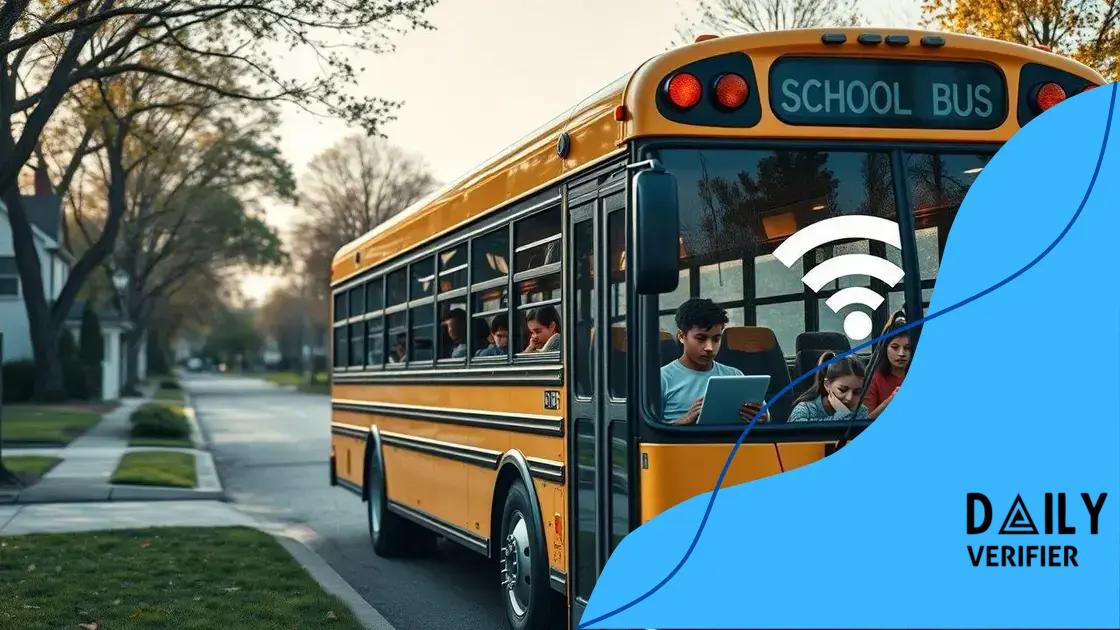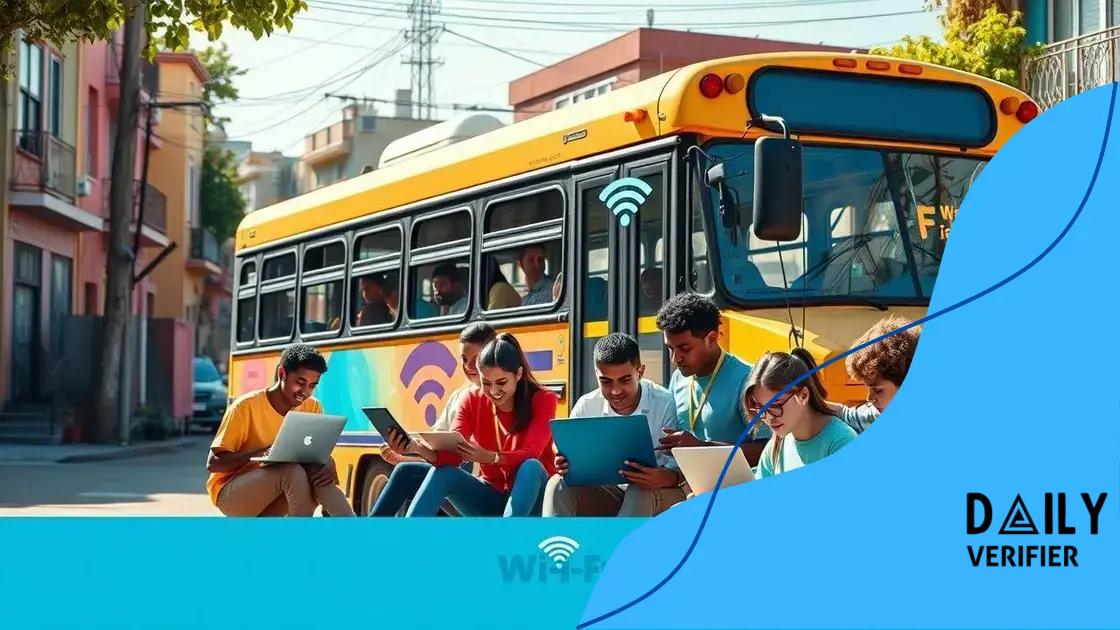Wi-Fi buses aid students in remote learning access

Wi-Fi buses aid students by providing essential internet access, enabling them to engage in online learning and complete assignments in underserved areas, thus bridging the digital divide in education.
Wi-Fi buses aid students by providing essential internet access, making remote learning opportunities available even in underserved areas. Have you ever thought about how this could change a student’s life?
The importance of internet access for students
Having access to the internet is crucial for students today. It opens up a world of educational resources and tools that can enhance learning.
Enhancing Learning Opportunities
When students have reliable internet access, they can explore various subjects in depth. This means they can watch videos, read articles, and participate in online discussions, all of which can deepen their understanding.
Key Benefits of Internet Access
- Access to information: Students can find study materials and research papers easily.
- Collaboration: Being online allows students to work together, even if they are in different locations.
- Flexible learning: Students can study at their own pace and revisit lessons as needed.
- Preparation for the future: Familiarity with technology is essential for future job opportunities.
Unfortunately, many students today lack this necessary access. This digital divide can hinder their academic success and limit their potential. In contrast, those who have internet access can take advantage of countless resources that support their education.
Wi-Fi buses are one innovative solution to combat this issue. By providing students with mobile internet access, these buses help bridge the gap in connectivity, especially for those in remote areas. With such resources, students can access online classes and complete assignments, making a significant difference in their educational journey.
How Wi-Fi buses are improving education
Wi-Fi buses are changing the educational landscape for many students. By providing reliable internet access, these buses help bridge the gap for those in need.
Accessibility for All Students
In many rural or underserved areas, schools struggle to provide internet access at home. Wi-Fi buses travel to these communities, offering students a connection they otherwise wouldn’t have. This access allows students to complete assignments, participate in online classes, and utilize educational resources.
Key Improvements in Education
- Encourages participation: Students can engage in virtual classrooms more effectively.
- Diverse learning methods: Access to online materials, such as videos and interactive tools, supports various learning styles.
- Boosts confidence: Students feel more confident when they can complete their work on time and access support.
Moreover, the presence of Wi-Fi buses can foster a sense of community. They often serve as gathering spots where students collaborate on projects. This not only enhances learning but also builds social skills.
With the help of Wi-Fi buses, educators can offer more comprehensive curricula. Teachers can assign projects that require research online, which promotes critical thinking and independence. As the availability of these buses increases, so does the potential for educational equality.
Real-life examples of successful Wi-Fi bus programs

Many communities have adopted Wi-Fi bus programs, leading to remarkable success stories. These programs demonstrate how mobile internet access can transform education.
Example 1: Rural School District
In a rural school district, Wi-Fi buses regularly visit neighborhoods where students lack reliable internet at home. These buses are equipped with strong signals and serve as mobile hotspots. Students gather around, using their laptops to complete assignments and participate in virtual classrooms. This initiative has significantly improved student engagement and performance.
Example 2: Urban Outreach Program
In an urban area, a non-profit organization launched a Wi-Fi bus initiative to target low-income families. The bus makes stops in various neighborhoods, enabling students to access online resources. By providing safe spaces for learning, the program has helped many children improve their academic skills.
Benefits Observed
- Increased attendance: More students feel encouraged to attend virtual classes.
- Supplemental learning: Access to online tools has widened opportunities for learning beyond the classroom.
- Community engagement: Wi-Fi buses often host workshops to educate parents and students on digital literacy.
These real-life examples show how Wi-Fi buses can make a difference. They are not just about providing internet; they create opportunities for learning and growth within the community.
Challenges faced by Wi-Fi bus initiatives
While Wi-Fi bus initiatives are making a significant impact, they also face several challenges that can hinder their effectiveness. Addressing these challenges is crucial for the success of these programs.
Technical Issues
One of the primary challenges is maintaining a strong and reliable internet connection. Not every area has the necessary infrastructure, which can lead to unreliable service. This inconsistency can frustrate students who depend on stable access for their studies.
Funding and Resources
Another significant hurdle is securing sufficient funding. Operating Wi-Fi buses requires ongoing financial support for maintenance, fuel, and equipment. Without consistent funding, programs may struggle to stay operational.
Community Awareness
In some cases, families may not be aware of available Wi-Fi bus services. This lack of awareness can result in low participation. Outreach efforts are essential to inform the community about the benefits and schedules of these buses.
Equity of Access
- Geographic limitations: Some areas may be too remote for regular routes.
- Diverse needs: Students have varying levels of tech proficiency, which can affect how effectively they use the resources.
- Safety concerns: Parents may worry about the safety of their children while using public transportation.
These challenges highlight the need for thoughtful planning and community involvement. By addressing these issues, Wi-Fi bus initiatives can become even more effective in bridging the digital divide for students.
Future possibilities for education with mobile Wi-Fi
The future of education is bright, especially with the rise of mobile Wi-Fi initiatives. These programs can change how students learn and access resources.
Expanding Access to Learning
Mobile Wi-Fi can reach students in the most remote areas. As technology evolves, we can expect more innovative ways to deliver high-speed internet. This means that education will become more equitable, as all students, regardless of location, can access online learning platforms.
Enhanced Learning Tools
With reliable internet access, students can utilize a wide array of digital tools and resources. For instance, they can engage in interactive lessons, access e-books, and participate in virtual reality experiences that make learning more engaging. These tools can cater to different learning styles and help students better grasp complex concepts.
Community Engagement
- Collaboration: Mobile Wi-Fi brings students together to work on projects, whether in a bus or at a community center.
- Support for Teachers: Educators can create more dynamic lesson plans by integrating technology into their teaching.
- Parental Involvement: Parents can also benefit from resources, learning how to support their children academically.
As mobile Wi-Fi continues to develop, there’s potential for partnerships with tech companies to innovate further. For example, incorporating AI-driven learning programs can personalize education based on individual student needs. This ensures that every student can progress at their own pace, receiving tailored support.
Ultimately, the use of mobile Wi-Fi in education can lead to a more connected and informed generation, ready for future challenges and opportunities.
In summary, mobile Wi-Fi initiatives are transforming education by providing essential internet access to students everywhere. These programs not only enhance individual learning experiences but also promote community collaboration and engagement. As we look to the future, the potential for mobile Wi-Fi to create a more connected and equitable educational landscape is very promising. Addressing challenges and exploring innovative technologies will ensure that all students have the opportunity to succeed.
\n\n
| Topic | Details |
|---|---|
| 📶 Accessibility | Mobile Wi-Fi expands internet access to underserved areas. |
| 🤝 Community Building | Encourages collaboration among students and parents. |
| 📚 Enhanced Learning | Access to diverse educational resources and tools. |
| 💡 Innovation | Integration of new technologies to improve learning experiences. |
| 🚀 Future Potential | Promising advancements for student success and equity. |
\n
FAQ – Frequently Asked Questions about Mobile Wi-Fi Buses in Education
What are Wi-Fi buses?
Wi-Fi buses are mobile vehicles equipped with internet access, providing connectivity to students in underserved areas.
How do Wi-Fi buses improve education?
They enhance access to online resources, enabling students to complete assignments and engage in virtual classes.
What challenges do Wi-Fi bus initiatives face?
Some challenges include maintaining reliable connections, securing funding, and community awareness.
What future possibilities exist for mobile Wi-Fi in education?
Future possibilities include personalized learning experiences, increased community engagement, and access to diverse educational tools.






